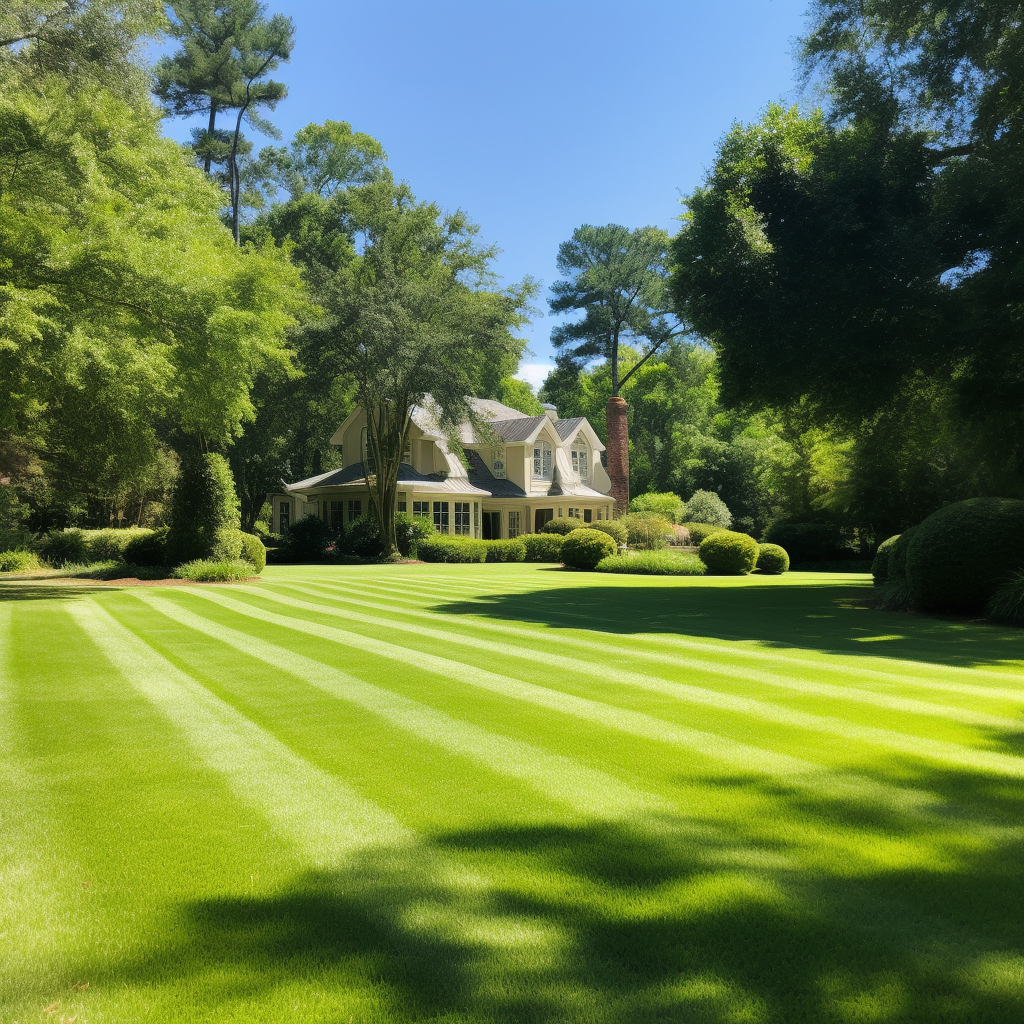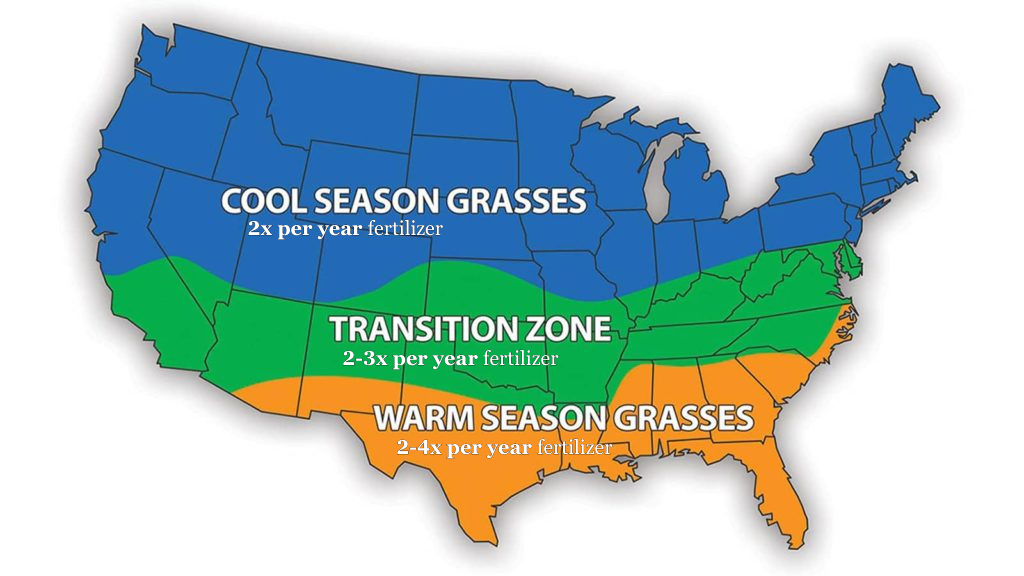
Welcome to the Turf Science Institute blog, where we bridge the gap between scientific discovery and practical lawn care. Today, we’re focusing on a common question many homeowners ask: “When do I fertilize my lawn?” Understanding the right timing for fertilizing your grass is crucial for maintaining a healthy, vibrant lawn. Here’s your comprehensive guide on when to put fertilizer on your lawn.
When Should You Fertilize Your Lawn?
Fertilizing your lawn is a vital aspect of lawn care. Our general recommendation is to apply fertilizer 2-4 times per year, depending on your specific climate and lawn care goals.
A great, simple approach is to fertilize twice per year: once in spring and once in fall. This works for every lawn. If you’re in a warmer climate where grass grows for 8+ months a year, you might want to fertilize more than 2x per year, but start with a simple 2x per year fertilization schedule if you’re a new lawn caretaker.
Four Steps to Know the Best Time to Fertilize
It’s essential to fertilize when your grass is actively growing, rather than when it’s dormant. You can determine if your lawn is active or dormant based on the soil temperature. In this step-by-step guide, you’ll learn how to schedule your fertilizer applications, so you can be confident you’re fertilizing at the right time.
- Determine grass type
- Target soil temperature
- Look up your soil temperature
- Schedule fertilizer applications
Cool-Season vs. Warm-Season: Grass Type Determines Fertilizer Timing
The type of grass you have significantly influences when to fertilize. Cool-season grasses thrive in lower temperatures and generally require less fertilizer compared to warm-season varieties. Bermuda grass, for instance, is a warm-season grass that needs more frequent feeding.

Check the map above to see where you fall. If you are in the transition zone, you could have either warm-season or cool-season grass. Try to identify your grass and see whether it’s warm-season (e.g., Bermuda, Zoysia, St. Augustine, Bahia) or cool-season (e.g., Fescue, Kentucky Bluegrass), because that’s an important starting point for most lawn care decisions.
Timing Based on Soil Temperature: Know Precisely When to Fertilize
The optimal time to fertilize is linked to soil temperature. Based on the soil temperature, you can be 100% sure that your grass is at the ideal stage for growth. While there are other factors such as water and sunlight that determine grass growth rates, the temperature is the primary trigger for dormancy vs. active growth. For warm-season grasses, the ideal soil temperature is between 70-90 degrees, while cool-season grasses flourish at 50-65 degrees. These grasses grow at drastically different temperatures. Now you see why it’s important to know your grass type!
| Grass type | Ideal soil temperature for fertilizing |
| Warm-season grass | 70-90° F (21-32° C) |
| Cool-season grass | 50-65° F (10-18° C) |
Look Up Soil Temperatures in Spring and Fall
There is a great resource provided by Greencast Online that will help you determine your soil temperature. Of course, you can also use a thermometer to measure soil temperature the old fashioned way.
If you use the tool provided at the link above, enter your zip code to see the current soil temperatures in your area. We have found the data here is accurate enough to inform decisions on when to fertilize.
Plan to Fertilize When Soil Reaches Ideal Temperatures
Based on the historical soil temperature averages in your area, plan to apply fertilizer when your soil is in the ideal ranges shown above.
As mentioned above, we encourage a roughly seasonal split — one spring, and one fall application — for simplicity. An annual “hello” and “goodbye” to your lawn’s growth season. We also include instructions below for an optional third application in the summer for warmer climates.
Keep in mind, as long as your soil temperature is in the ideal range, you are good to go! Don’t worry about whether you apply in March or April as long as your soil is warm enough for your grass to grow.
Spring Fertilizer Application
When applying fertilizer in spring, ensure that the last frost has passed. Even if it feels warm enough, a sudden temperature drop could hinder your lawn’s growth. After you’re confident you’ve had your last frost (i.e., night with sub-freezing temperatures), then you can fertilize as soon as your soil reaches your optimal temperature! Monitor the soil temperature and begin fertilizing when it reaches:
- Warm-season grass: 70 to 90° Fahrenheit (21 to 32° Celsius)
- Cool-season grass: 50 to 65° Fahrenheit (10 to 18° Celsius)
Fall Fertilizer Application
In fall, aim to fertilize at least 3-6 weeks before the first winter frost. If you apply seed in the fall (commonly known as “overseeding”), fertilize after seeding. Keep an eye on the soil temperature to ensure it’s within the ideal range for your grass type:
- Warm-season grass: 70 to 90° Fahrenheit (21 to 32° Celsius)
- Cool-season grass: 50 to 65° Fahrenheit (10 to 18° Celsius)
Summer Fertilizer Application (Optional)
In warmer climates with extended growing seasons, consider an additional fertilizer application in mid-year. This is particularly beneficial for nutrient-hungry warm-season grasses like Bermuda. Some lawns may even benefit from two extra summer applications, totaling four yearly applications.
Keep in mind, it will get too hot to fertilize in some areas in the summer. Cool-season grass goes dormant in the summer, but even very hot Texas summers can send soil temps above 90 and a Bermuda lawn into dormancy. So even though you’re in the “middle” of the growing season, keep an eye on soil temperatures to make sure it’s not too hot.
Other Considerations About When to Fertilize Your Lawn
There are other variables at play in determining the optimal lawn fertilization schedule. If, for example, your lawn is newly seeded, you may want to fertilize more frequently, using a formula with extra phosphorous to jumpstart root growth. If you have a pet that uses your yard as a restroom, you may need to add soil amendments such as humic acids throughout the year. Live in a location with acidic soil (i.e., the Southeast)? You may also need to apply lime every 1-2 years to keep your soil pH above 6.0.
Your Lawn is a Living Ecosystem, Be Flexible About When to Apply Fertilizer
Your lawn will often tell you what it needs. If it appears undernourished, it might need more fertilizer. On the flip side, over-fertilizing or fertilizing when the lawn is dormant can lead to nitrogen burns. To avoid this, know your grass type, the optimal soil temperatures for growth, and regularly check local soil temperatures. Remember, fertilize your soil when it’s:
- Warm-season grass: 70 to 90° Fahrenheit (21 to 32° Celsius)
- Cool-season grass: 50 to 65° Fahrenheit (10 to 18° Celsius)
By following these guidelines, you can ensure your lawn remains healthy and vibrant throughout the year. For more lawn care tips and insights, stay tuned to our blog at the Turf Science Institute, where we make science practical for your lawn care needs.
Leave a Reply